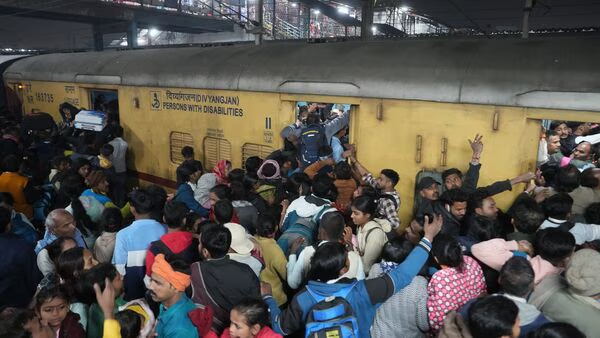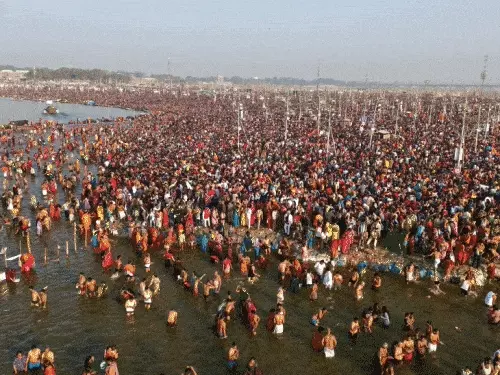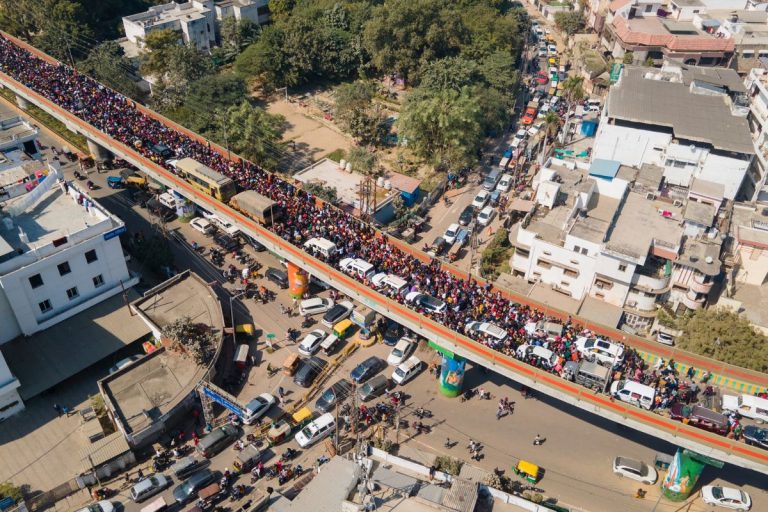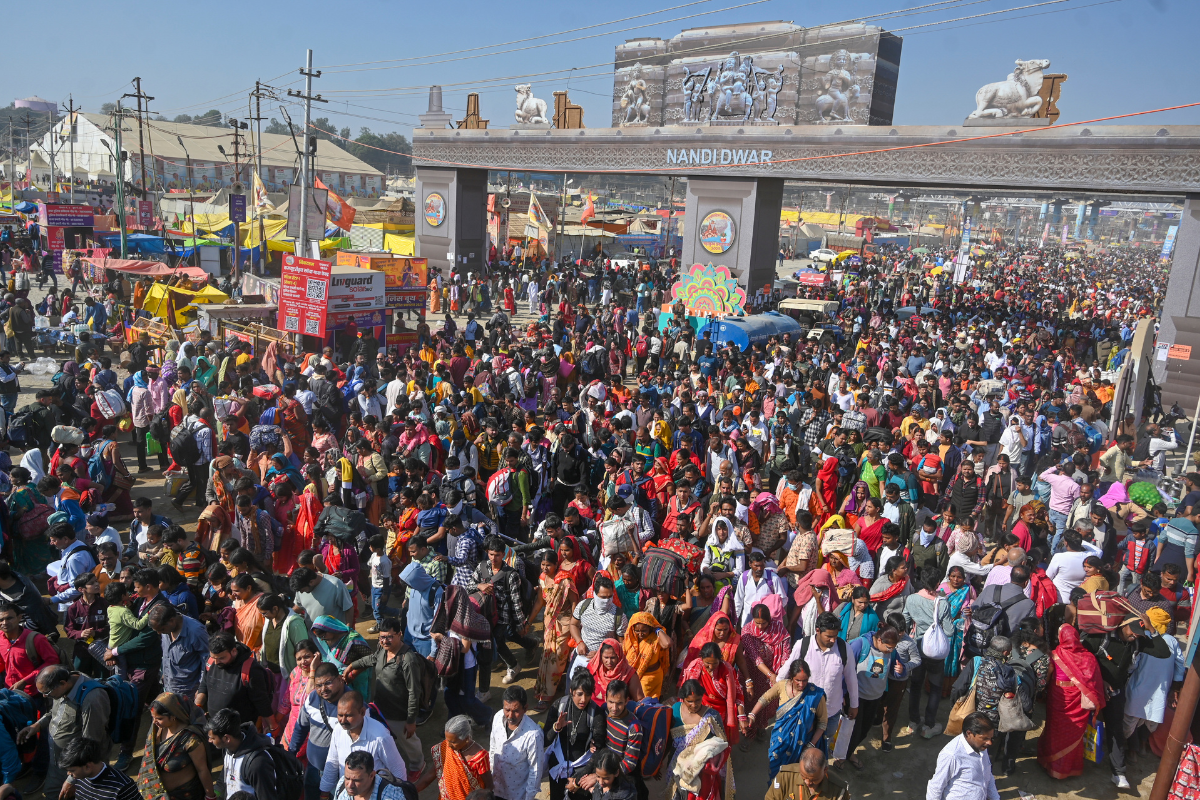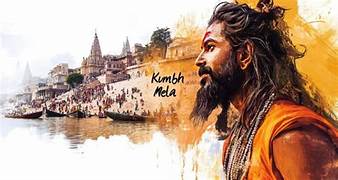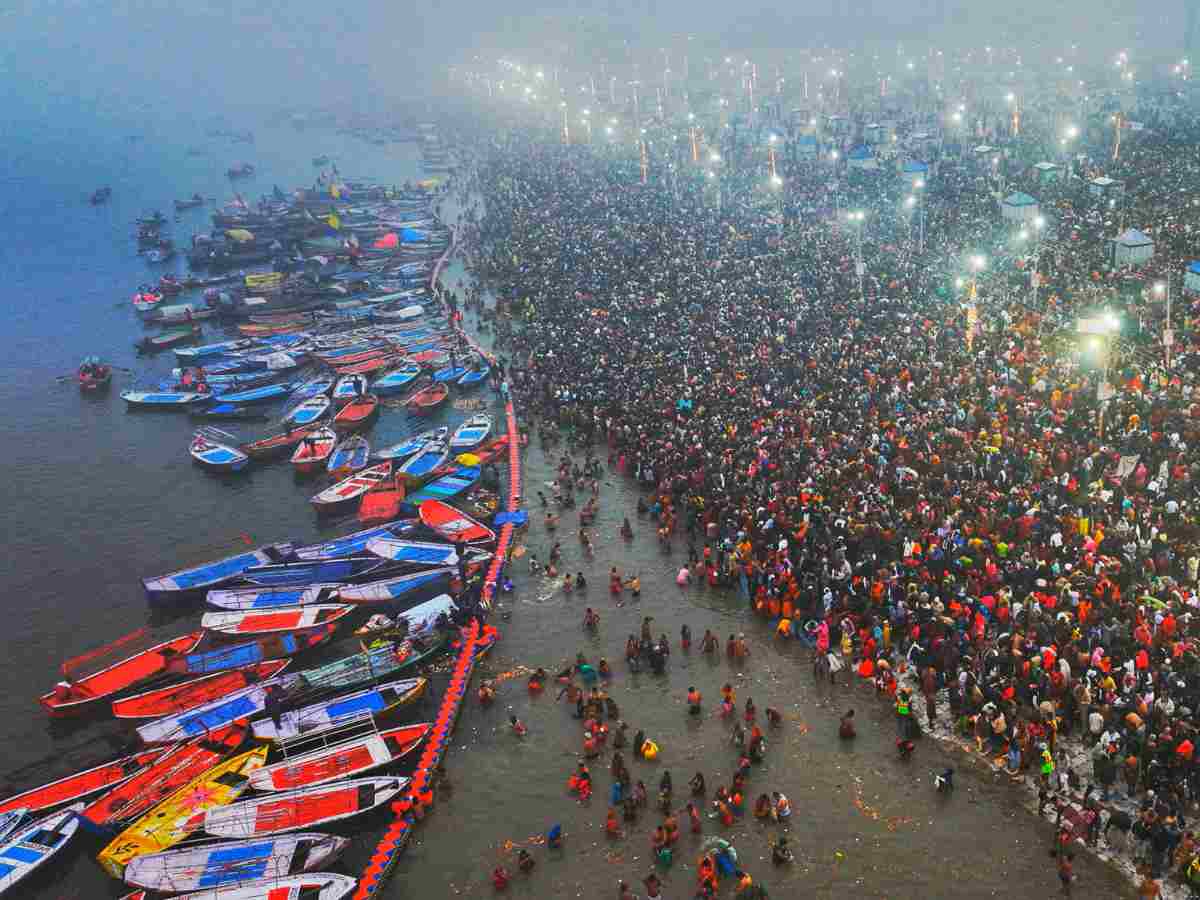
Maha Kumbh Mela 2025: Mahakumbh 2025 in Prayagraj is poised to be a monumental spiritual event, drawing over 450 million devotees from around the world. This sacred gathering, deeply rooted in Sanatan Dharma, showcases centuries-old traditions and cultural grandeur. With cutting-edge technology, advanced safety measures, and extensive planning, it promises a secure and transformative experience for pilgrims.
The Maha Kumbh Mela is a major Hindu festival held every 12 years in Prayagraj, India. It began on January 13, 2025, and will continue until February 26, 2025. This event is expected to attract around 400 million (40 crores) visitors, making it the world’s largest religious gathering.
The festival’s origins are rooted in Hindu mythology, symbolising the victory of gods over demons. Devotees believe that bathing at the confluence of the Ganges, Yamuna, and mythical Saraswati rivers cleanses sins and leads to salvation.
To accommodate the massive influx of pilgrims, authorities have established a temporary city spanning 4,000 hectares.
This includes 150,000 tents, enhanced sanitation facilities, and improved transportation services. Security measures involve deploying 40,000 police officers and AI-powered surveillance systems to ensure safety.
The Maha Kumbh Mela is not only a significant religious event but also a testament to India’s ability to manage large-scale gatherings, reflecting the nation’s rich cultural heritage.
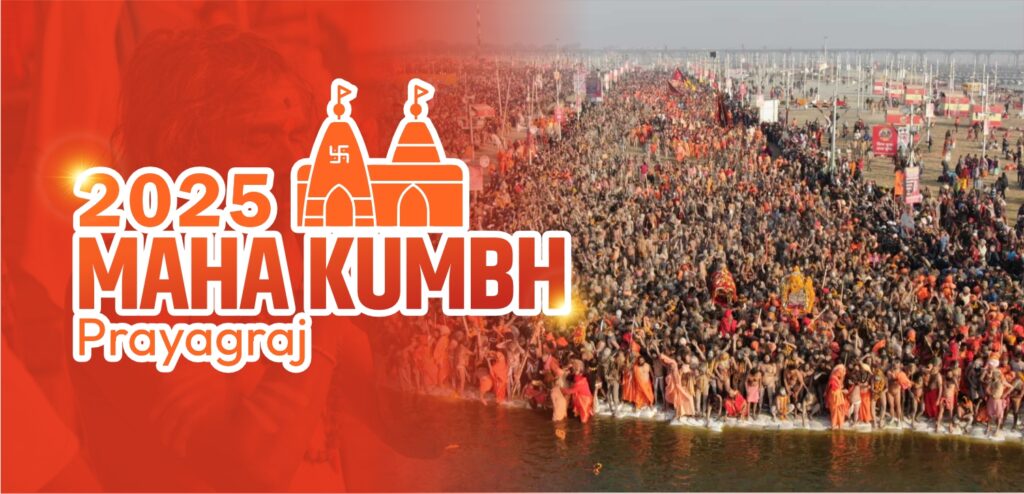
Significance of the Maha Kumbh Mela in Hindu Tradition
This year the Mahakumbh Mela started on the auspicious day of Paush Purnima, which fell on January 13, 2025, and will continue until February 26, 2025. This year’s Mahakumbh Mela is unique in itself since the constellation alignment is witnessed once every 144 years.
Maha Kumbh Mela is one of the largest and most revered religious gatherings in Hinduism, celebrated every twelve years at four sacred locations: Prayagraj (formerly Allahabad), Haridwar, Ujjain, and Nashik.
This festival holds profound spiritual significance, deeply rooted in Hindu mythology and tradition.
1) Mythological Origins
The origins of the Kumbh Mela are linked to the Samudra Manthan, or the churning of the ocean, where gods (Devas) and demons (Asuras) collaborated to obtain Amrit, the nectar of immortality.
According to legend, during this process, a pot (Kumbh) containing Amrit emerged. To prevent the demons from claiming it, Lord Vishnu, disguised as Mohini, took the pot and fled. In the process, drops of Amrit fell at four locations: Prayagraj, Haridwar, Ujjain, and Nashik.
These sites have since become sacred pilgrimage destinations for Hindus, believed to bestow spiritual benefits upon those who bathe in their waters during the festival.
2) Spiritual Significance
The central ritual of the Maha Kumbh Mela is the Shahi Snan, or royal bath, where millions of pilgrims immerse themselves in the holy rivers at auspicious times.
This act is believed to cleanse individuals of their sins and liberate them from the cycle of rebirth (samsara), ultimately leading to Moksha or spiritual liberation. The confluence of the Ganga, Yamuna, and the mythical Saraswati at Prayagraj is particularly revered as a site for attaining salvation.
3) Cultural and Social Aspects
Beyond its religious implications, the Maha Kumbh Mela serves as a vibrant cultural festival that brings together diverse groups of people.
It includes ascetics (sadhus), pilgrims, and visitors who engage in various rituals such as fasting, charity, and communal prayers. The gathering fosters a sense of unity among participants, transcending differences in caste and creed.
The event also showcases India’s rich heritage through its rituals and practices that are passed down through generations.
Record-Breaking Statistics: The Scale of Maha Kumbh 2025
The Maha Kumbh Mela attracted more than 400 million visitors worldwide. Numerous international pilgrims and tourists, such as YouTubers from South Korea and travellers from Japan, Spain, Russia, and the United States, were enchanted by the event’s splendour.
At the Sangam Ghat, many interacted with local guides to gain insight into the cultural and spiritual significance of the Maha Kumbh.
This 45-day spiritual and cultural event witnessed the coming together of people from all corners of the globe to participate in rituals, prayers, and discussions about faith and spirituality.
The UP Government, acknowledging the spiritual significance of the Sangam Snan, made substantial efforts to enlarge the bathing area.
In an impressive achievement, the irrigation department reclaimed more than 2 hectares of land at Triveni Sangam within just 85 days, allowing two lakh devotees to bathe at once.
With the use of four dredging machines, an additional 26 hectares of land have been reclaimed. This careful dredging process has tripled the Sangam’s capacity compared to 2019.
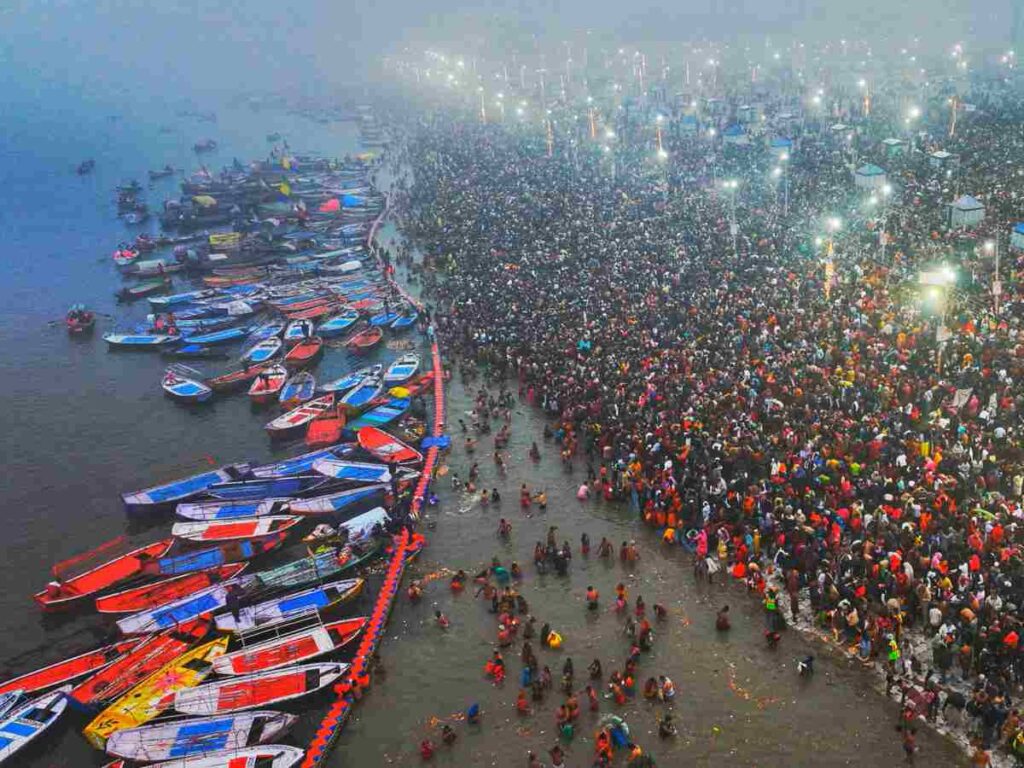
These enhancements promise a smooth bathing experience for the anticipated 45 crore devotees during the Maha Kumbh.
1) Attendance Expectations
- Total Pilgrims Expected: Approximately 40 to 45 crore (400 to 450 million) devotees are anticipated to attend over the 45 days.
- Kalpvasis: An estimated 15 to 20 lakh (1.5 to 2 million) Kalpvasis (those who stay for the entire duration) are expected, up from 10 lakh in 2019.
- Peak Days: A significant influx is expected on key bathing dates, particularly during Mauni Amavasya, where estimates suggest 8 to 10 crore (80 to 100 million) visitors may participate.
2) Infrastructure and Logistics
- Mela Area: The event will cover approximately 4,000 hectares, a 25% increase from the previous Kumbh Mela held in 2019.
- Sectors: The area has been divided into 25 sectors, compared to 20 sectors in 2019, enhancing crowd management.
- Ghat Lengths: The total length of bathing ghats has increased from 8 kilometres in 2019 to 12 kilometres in 2025.
- Parking Facilities: Parking space has expanded to 1,850 hectares, up from 1,291 hectares previously.
- Road Infrastructure: The total road length within the Mela area has increased from 299 kilometres to over 450 kilometres.
3) Budget and Economic Impact
- Estimated Budget: The budget for managing the Maha Kumbh Mela is set at around ₹7,500 crore (approximately $903.61 million), a significant increase from previous events.
- Economic Transactions: The Maha Kumbh Mela is expected to garner an estimated amount of ₹2 lakh crore to ₹2.5 lakh crore (approximately $25 billion to $30 billion), which may account for about 0.8% of India’s GDP, according to Confederation of All India Traders (CAIT).
- Tourist Spending: If every tourist spends ₹5,000 during their trip, the Maha Kumbh Mela is most likely to generate an estimated amount of ₹2 lakh crores. Additionally, according to CIAT, approx. ₹40,000 crore is likely to be generated by local guesthouses, hotels, motels, restaurants and more.
- The helicopter service costs around ₹5,000 per trip which takes 7,000 pilgrims daily. If this betided for 45 days, this only service can generate up to ₹157.5 crore in total (₹3.5 crore per day).
4) Sanitation and Safety Measures
- Toilets and Facilities: Approximately 1.50 lakh toilets will be set up, an increase from 1.14 lakh in 2019. Public accommodation beds have also risen from 20,000 to 25,000.
- Security Personnel: More than 45,000 police personnel, along with over 55 police stations, will be deployed for safety and security throughout the event.
- Surveillance Technology: Over 3,000 cameras will monitor the area as part of enhanced security measures.
Key Dates and Rituals at the Prayagraj Kumbh Mela
The Maha Kumbh Mela 2025 is a significant Hindu festival taking place in Prayagraj, Uttar Pradesh, from January 13 to February 26, 2025. Below are the key dates and rituals associated with this grand religious gathering.
Key Dates
| Date | Event | Description |
| January 13, 2025 | Paush Purnima | Official start of the Maha Kumbh Mela; significant bathing day. |
| January 14, 2025 | Makar Sankranti | First Shahi Snan (royal bath), a major highlight of the festival. |
| January 29, 2025 | Mauni Amavasya | Second Shahi Snan; believed to be highly auspicious for cleansing sins. |
| February 3, 2025 | Basant Panchami | Third Shahi Snan; marks the arrival of spring and is significant for devotees. |
| February 12, 2025 | Maghi Purnima | Important bathing day; an opportunity for spiritual renewal. |
| February 26, 2025 | Maha Shivratri | Concludes the Maha Kumbh Mela; another important bathing day. |
- Shahi Snan (Royal Bath): The Shahi Snan is a sacred dip taken by saints and prominent spiritual leaders in the holy rivers. It is believed that participating in this ritual cleanses sins and brings divine blessings.
- Ritual Bathing: Devotees take ritual baths at designated times throughout the Mela, particularly on auspicious days, seeking purification and liberation (moksha).
- Sankirtan and Bhajans: Pilgrims engage in singing hymns and devotional songs, filling the atmosphere with spiritual energy.
- Yoga and Meditation: Various sessions of yoga and meditation are conducted to promote physical, mental, and spiritual well-being among attendees.
- Spiritual Discourses: Renowned scholars and spiritual leaders deliver sermons and philosophical talks, providing insights into Hindu teachings and practices.
- Community Gatherings: The Mela serves as a platform for communal gatherings where pilgrims share experiences and strengthen their faith together.
